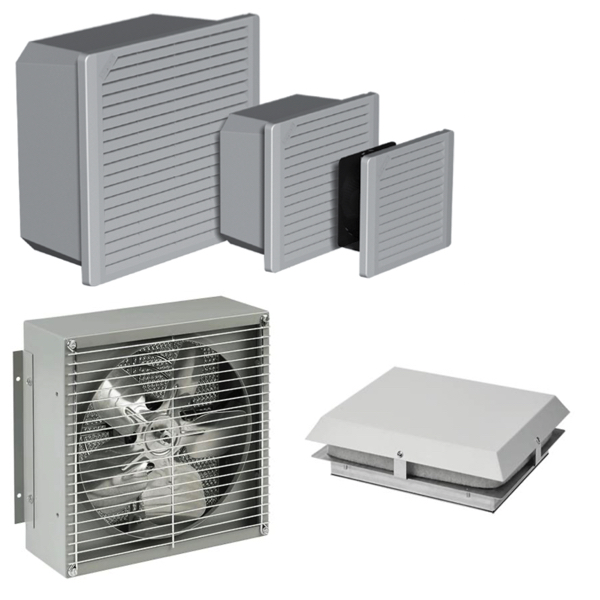Enclosure Fans & Ventilation

Enclosure fans and ventilation systems are essential for managing heat and airflow inside electrical and industrial enclosures that house heat-generating components. By removing warm internal air and introducing cooler ambient air, these products help regulate internal temperatures, reduce thermal stress, and protect sensitive equipment from overheating and premature failure.
This category includes enclosure fans, exhaust fans, venting panels, and filter fan assemblies designed for open-loop cooling applications. Axial enclosure fans provide forced-air ventilation and can be mounted on enclosure doors, side panels, roofs, or rear panels depending on airflow design requirements. Filter fans add an extra layer of protection by preventing dust, dirt, and airborne contaminants from entering the enclosure, making them suitable for industrial and outdoor environments.
Ventilation solutions may also include passive venting options that support natural convection cooling in lower-heat applications. For harsher environments, enclosure fans and vents are available with NEMA or IP ratings to protect against moisture, humidity, and environmental ingress. Proper selection of fans and ventilation components helps maintain airflow balance, manage static pressure, and ensure long-term enclosure and equipment reliability.
FAQs
Q: What are enclosure fans and ventilation systems used for?
Enclosure fans and ventilation systems are used to manage internal temperatures and airflow within electrical enclosures by removing heat and allowing cooler air to circulate.
Q: What is the difference between exhaust fans and filter fans?
Exhaust fans remove hot air from inside an enclosure, while filter fans bring in filtered ambient air to maintain cleanliness and positive pressure inside the cabinet.
Q: Can venting panels help reduce static pressure in an enclosure?
Yes, venting panels can help relieve static pressure by allowing air to move more freely through the enclosure, supporting more efficient airflow and cooling.
Q: Are enclosure fans suitable for outdoor use?
Many enclosure fans and ventilation products are rated for outdoor use and carry NEMA or IP ratings that protect against dust, moisture, and environmental exposure.
Q: How do I determine the right ventilation solution for my enclosure?
Selection depends on enclosure size, internal heat load, ambient temperature, environmental conditions, and whether forced-air or passive cooling is required.
Why Buy Enclosure Fans & Ventilation Products from RSP Supply
RSP Supply offers a broad selection of enclosure fans and ventilation products to support effective thermal management in electrical and industrial enclosures. Customers rely on RSP Supply for access to trusted manufacturers, detailed technical product information, and knowledgeable support to help ensure proper cooling, airflow design, and long-term equipment protection.

